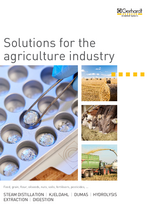Without agriculture, there would be no food. A functioning agricultural sector is therefore essential for our everyday lives. Cereal cultivation is at the heart of agriculture. Cereals are cultivated sweet grasses that bear grains. These grains are particularly nutritious, versatile and easy to store - ideal conditions for a staple food.
Importance and analysis of grain
Particularly popular cereals are wheat, rye, barley and oats, as well as rice, millet and maize. We use cereals, for example, to bake bread and as a basis for main dishes. In short: cereals are omnipresent as food. However, this does not only apply to our food, as feed for cows, pigs and chickens is also often based on grain.
To ensure that food and feed containing grain also contain the desired nutrients, regular analyses are recommended. When analyzing cereals, the parameters nitrogen and protein are of particular interest. The official methods of international associations such as AOAC International and AACC specify analysis standards.
Good soil quality and efficient fertilisers are important prerequisites for successful grain cultivation. Good, or fertile, soil is characterized by a high nutrient supply, good aeration, high water storage capacity and the absence of pollutants.
Soil analysis for nutrients and pollutants
One important nutrient in the soil is nitrogen, for example. Nitrogen is important for plant growth and is available in the soil in form of ammonium (NH4) and nitrate (NO3). If the nitrogen content is particularly high, this can lead to acidification of the soil - a situation that must be avoided. It is therefore recommended to check the nitrogen content in the soil regularly. A nitrogen analysis according to Dumas or Kjeldahl can help.
Another factor that influences soil quality is the pollutant content. Dioxins, polychlorinated biphenyls (PCBs), polycyclic aromatic hydrocarbons (PAHs) and extractable organically bound halogens (EOXs) often accumulate in soils. These are substances that have a significant impact on our environment and our health. Regular soil tests using solid-liquid extraction allow us to keep an eye on the pollutant content and take appropriate measures if necessary.
Use of fertilisers
In addition to good soil quality, the use of fertilisers also plays an important role in agriculture. Fertilisers increase the supply of nutrients to crops and thus ensure faster growth and higher yields. The content of nitrogen and nitrogen-containing compounds, such as ammonium and nitrate, in fertilisers is determined using the Kjeldahl or Dumas method.
Each sample from the agricultural sector requires a specific analysis method. C. Gerhardt rises to the challenge and provides various solutions.
We are particularly well positioned in the field of nitrogen and protein analysis. We offer semi-automated and fully automated solutions according to Kjeldahl and Dumas and thus meet various requirements. With our systems, you can also carry out every step of fat analysis according to Weibull-Stoldt: from hydrolysis to solid-liquid extraction. We are also specialists in the field of fiber extraction. From crude fiber to ADF and NDF, we cover everything.
We have also developed special applications for sulphur dioxide analysis. On the one hand, we offer a space-saving alternative to the optimized Monier-Williams method and, on the other, a particularly time-saving method with our VAPODEST systems. As you can see, we are also able to cater to different needs and provide you with the right solution.
Please click through our website below and familiarize yourself with our product portfolio. If you have any questions or require advice, please do not hesitate to contact us.








![[Translate to English:] [Translate to English:]](/fileadmin/_processed_/d/4/csm_Application_notes_Bilder_fuer_UEbersicht_feed_dumas_2b755ea15e.jpg)
![[Translate to English:] [Translate to English:]](/fileadmin/_processed_/5/9/csm_Application_notes_Bilder_fuer_UEbersicht_crude_fibre_in_feed_525f424910.jpg)
![[Translate to English:] [Translate to English:]](/fileadmin/_processed_/0/5/csm_Application_notes_Bilder_fuer_UEbersicht_duenger_c2fc3a6ed0.jpg)
